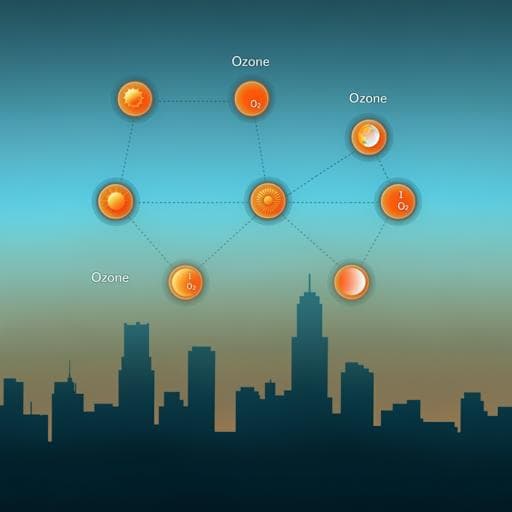
Environmental Studies and Forestry
Disentangling drivers of air pollutant and health risk changes during the COVID-19 lockdown in China
F. Shen, M. I. Hegglin, et al.
Discover how the COVID-19 lockdown and other factors influenced air quality in China! This research reveals significant reductions in NO2 levels and highlights the impact of China's Clean Air Plan, authored by experts including Fuzhen Shen and Michaela I. Hegglin.
~3 min • Beginner • English
Introduction
Air pollution is a leading global health risk, causing millions of premature deaths, including 1.85 million in China in 2019. Primary emissions (NOx, CO, SO2) and secondary pollutants (O3, PM) are modulated by meteorology, complicating attribution of air-quality changes. China’s COVID-19 lockdown began on January 23, 2020, coinciding with the Chinese New Year (CNY), both of which reduce activity-related emissions. Concurrently, China’s Clean Air Plans (CAP) from 2013–2017 and the intensified 2018–2020 measures targeted emission reductions, particularly for NOx. Meteorological variability also importantly influences pollutant levels. The research question is to quantify and disentangle the relative contributions of CNY, CAP (2018–2020), COVID-19 lockdown measures, and meteorology to changes in NO2 and O3 across Chinese cities during early 2020, and to assess the consequent health risk changes using a multi-pollutant health index (HAQI).
Literature Review
Multiple studies reported substantial NO2 reductions during early 2020 using various baselines: relative to multi-year pre-2020 periods (ground-based: ~51.5±14.3%; satellite: ~44.3±21.0%), relative to 2019 only (ground-based: ~45.7±15.8%; satellite: ~37.7±10.0%), and relative to pre-lockdown 2020 (ground: ~53±12.7%; satellite: ~53.4±14.9%). Modeling (BAU) and ML-based counterfactual approaches estimated NO2 declines of ~54.4±8.3% and ~44.1±9.4%, respectively. However, most prior studies did not isolate the contributions of CNY and CAP during 2020, nor did many account for meteorology at a national scale, and largely focused on limited pollutants/regions. Some works decomposed meteorological versus anthropogenic effects (e.g., for PM2.5) or used CTMs for O3 but comprehensive, city-level, multi-driver attribution across China remained limited.
Methodology
Data and study design: Daily concentrations of PM2.5, PM10, SO2, NO2, O3, and CO for 367 mainland Chinese cities (2015–2020) were obtained from the China National Environmental Monitoring Center. Hourly surface meteorological data (T, RH, WS, WD, precipitation, pressure) for 2425 stations were sourced from the National Meteorological Science Data Center, with 367 stations nearest to air-quality sites selected. NO2 and O3 reanalysis fields were taken from ECMWF’s CAMS Reanalysis (CAMSRA), which uses emissions that do not include CNY, CAP, or COVID-related reductions; hence CAMSRA acts as a counterfactual.
CAMSRA–observation comparison and filtering: CAMSRA fields were interpolated to station locations. Linear fits between CAMSRA and observations (2015–2019) were used to compute slope and PCC; cities with 0.5 < slope < 1.5 and PCC > 0.2 were retained, removing 87 outliers. Post-filtering, average PCCs were 0.51 (NO2) and 0.64 (O3).
Definition of time periods relative to the CNY day (X): Before CNY: days −21 to −8; CNY: days −7 to +10; Extended COVID-lockdown: days +11 to +42; Total COVID-lockdown: days −1 to +42.
Attribution framework (Drivers and formulas correspond to Table 1):
- Driver 1 (CNY 2015–2019): Percentage change = [Obs(YX) − CAMS(YX)]/CAMS(YX) × 100% during CNY (−7 to +10), averaged over 2015–2019.
- Driver 2 (CNY 2020-mix): Same formula during CNY period in 2020.
- Driver 3 (CAP 2018–2020): [Obs(YX) − CAMS(YX)]/CAMS(YX) × 100% during Before CNY (−21 to −8), averaged over 2018–2020.
- Driver 4 (CNY 2020-mix − CAP): Isolates CNY 2020 after excluding CAP effect.
- Driver 5 (COVID-lockdown effect): CNY 2020-mix − CNY 2015–2019 − CAP 2018–2020, representing the additional change attributable to COVID measures.
- Driver 6 (Meteorology effect): Using ML predictions, Met effect = [ML(Met-2020) − ML(Met-2015–2019)]/ML(Met-2015–2019) × 100% during Extended COVID-lockdown (+11 to +42).
Machine learning (ML) for meteorology normalization and prediction: A Gradient Boosting Machine (GBM) was trained city-wise using meteorological and time variables (Julian day, day of week, hour, CNY flag, date index) from 2015–2019 to predict pollutant concentrations for early 2020. Time-series split rolling cross-validation (five splits) ensured training data preceded validation, with testing on the first three months of 2016–2020. Performance: training RMSE ~6.9 µg/m³ and PCC ~0.85; prediction RMSE ~13.2 µg/m³ and PCC ~0.71 for NO2. Two ML experiments estimated the meteorology effect by comparing predictions driven by 2020 meteorology versus 2015–2019 mean meteorology using the same trained model. The same ML framework was applied for PM2.5, PM10, SO2, and CO to assess health risk impacts.
Health risk assessment (HAQI): Excess risks (ER) for six pollutants were computed using exponential exposure–response functions with β values for short-term mortality derived for China (PM2.5: 0.038% per µg/m³; PM10: 0.032%; SO2: 0.081%; NO2: 0.13%; O3: 0.048%; CO: 3.7% per mg/m³). Thresholds (C0) followed WHO 2021 guidelines and, separately, China’s CAAQS-II. Total ER was summed across pollutants and converted to an equivalent concentration for deriving the Health-based AQI (HAQI). O3 was represented by daily 8-hour peak values. HAQI was computed for observed 2020, COVID-19 counterfactual (BAU), and meteorology-attributed differences, including regional analyses.
Key Findings
- NO2 attribution (national averages):
- CNY (2015–2019): −26.7% (one-sigma: −51.7% to −1.7%).
- CAP 2018–2020: −15.7% ± 28.1%.
- CNY 2020-mix: −54.0% ± 19.4%.
- COVID-lockdown (isolated during CNY 2020 after excluding CAP and CNY baselines): −11.6%.
- Extended COVID-lockdown (after excluding CAP): −34.7% ± 16.9%.
- Meteorology (Total COVID-lockdown): +7.8% ± 14% (adverse to clearing NO2).
- O3 attribution (national averages):
- CNY (2015–2019): +23.3% (one-sigma: −18.6% to +65.2%).
- CAP 2018–2020: +4.9% ± 38.9%.
- CNY 2020-mix: +49.3% ± 85.2%.
- COVID-lockdown (isolated during CNY 2020 after excluding CAP and CNY baselines): +21.0%.
- Extended COVID-lockdown (after excluding CAP): +22.7% ± 22.5%.
- Meteorology (Total COVID-lockdown): −0.9% (small overall effect).
- Population-intensive cities (>5 million) showed larger NO2 decreases (e.g., CNY effect −32.4% ± 17.3%) and consistent O3 increases (e.g., +48.5% ± 27.6%), indicative of VOC-limited O3 chemistry and unbalanced precursor controls.
- Health risk (HAQI and ER):
- In 31 provincial capitals, BAU WHO-HAQI averaged 287; under COVID-19 lockdown, it decreased to 179 (reported average decline 61%). CAAQS-HAQI decreased from 102 to 75 (−21%), shifting to “good”.
- Across all cities, WHO-HAQI decreased on average by −51.4%.
- ER differences (capitals, WHO thresholds): NO2 −2.2% (largest contributor to ER decrease), PM2.5 −0.77%, PM10 −1.03%, SO2 −0.05%, CO 0, O3 +0.1% (O3 increase partly offset by NO2 decrease).
- Regional WHO-HAQI reductions (COVID vs BAU): YRD −98%, CC −93%, NCP −76%, SCB −69%, FWP −59%, PRD −55%, NEC −50%, NWC −34%, QTP −20%, YGP −14%.
- Meteorology worsened WHO-HAQI in 188 cities (51.5%), notably in NEC, Inner Mongolia, and parts of NCP and YRD, but benefits from emission reductions dominated in many core regions.
- CAMSRA–observation analyses confirmed: CNY causes consistent NO2 dips each year; CAP 2018–2020 introduced clear pre-CNY declines not present in 2015–2017, evidencing policy effectiveness.
- Not accounting for CAP and meteorology leads to misattribution: overestimation of COVID effect on NO2 decreases if CAP is ignored, and underestimation if meteorology is ignored.
Discussion
The study isolates overlapping influences of short-term (CNY holiday, COVID-19 restrictions) and long-term (CAP 2018–2020) emission changes alongside meteorological variability. Results show that beyond the substantial CNY-driven NO2 decreases, CAP policies produced significant additional NO2 reductions pre-2020, demonstrating regulatory effectiveness. The incremental NO2 reduction attributable solely to COVID-19 was more modest once CAP and routine CNY effects were removed, while meteorology in early 2020 actually favored higher NO2, partially masking emission reduction benefits. In contrast, O3 generally increased under all anthropogenic drivers (CNY, CAP, COVID), consistent with VOC-limited regimes and reduced NO titration, underscoring the need for balanced NOx–VOC controls. Health-risk analyses (HAQI) indicate large net benefits dominated by NO2, PM2.5, and PM10 reductions, with O3 increases offset by NO2 decreases; however, adverse meteorological conditions, especially in NEC and northern regions, eroded benefits locally. Collectively, findings highlight the necessity of multi-driver attribution for accurate assessment and policy evaluation and stress that meteorology can significantly modulate realized air-quality and health outcomes.
Conclusion
This work provides a comprehensive, city-level attribution of NO2 and O3 changes during early 2020 in China, separating the effects of CNY, CAP 2018–2020, COVID-19 lockdown measures, and meteorology using a combined CAMSRA–observation framework and ML-based meteorology normalization. Key contributions include quantifying CAP’s NO2 reduction (−15.7%), isolating the additional COVID-19 effect (−11.6% during CNY 2020; −34.7% during the extended period after excluding CAP), and demonstrating meteorology’s adverse role for NO2 (+7.8%). O3 increases across drivers reveal VOC-limited conditions and the consequences of unbalanced precursor controls. Health risk (WHO-HAQI) declined markedly nationwide, though meteorology reduced benefits in parts of the Northeast and North China. Future work should: (1) refine VOC–NOx control strategies regionally to curb O3 while sustaining PM/NO2 gains; (2) improve counterfactual modeling with updated, high-resolution emissions and assimilation that better constrain surface levels; (3) expand multi-pollutant, multi-driver attribution to longer periods and additional health endpoints; and (4) incorporate climate-driven meteorological shifts into air-quality management planning.
Limitations
- CAMSRA counterfactual assumes emissions without CNY, CAP, or COVID changes; reanalysis assimilation has limited ability to correct surface concentrations, potentially biasing the counterfactual baseline.
- 87 cities were excluded as outliers due to weak CAMSRA–observation agreement, which may affect national representativeness.
- ML predictions depend on the chosen features and training period (2015–2019) and do not explicitly model chemical mechanisms; residual confounding by unobserved factors is possible.
- O3 chemistry and precursor controls are complex; lack of explicit VOC emissions/inventories limits mechanistic attribution of O3 changes.
- Health risk estimates (HAQI/ER) rely on assumed β coefficients and threshold choices (WHO vs CAAQS-II), and short-term metrics; they do not capture all morbidity/mortality pathways or long-term effects.
- The study period focuses on early 2020; seasonal and interannual variability beyond this window are not fully explored.
Related Publications
Explore these studies to deepen your understanding of the subject.







